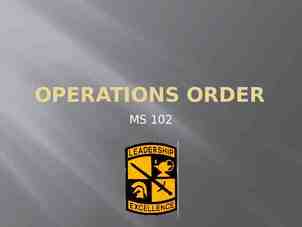Strategy Formulation: Situation Analysis and Business Strategy
37 Slides1.43 MB
Strategy Formulation: Situation Analysis and Business Strategy Chapter 6
Learning Objectives Organize environmental and organizational information using a SWOT approach and the SFAS matrix Understand the competitive and cooperative strategies available to corporations List the competitive tactics that would accompany competitive strategies Identify the basic types of strategic alliances Copyright 2015 Pearson Education, Inc. 6-2
Situational Analysis: SWOT Approach Strategy formulation concerned with developing a corporation’s mission, objectives, strategies and policies Situation analysis the process of finding a strategic fit between external opportunities and internal strengths while working around external and internal weaknesses Copyright 2015 Pearson Education, Inc. 6-3
Situational Analysis: SWOT Approach SWOT acronym used to describe the particular Strengths, Weaknesses, Opportunities and Threats that are potential strategic factors for a specific company Strategy opportunity/capacity Opportunity has no real value unless a company has the capacity to take advantage of that opportunity. Copyright 2015 Pearson Education, Inc. 6-4
Criticisms of SWOT analysis It is simply the opinions of those filling out the boxes. Virtually everything that is a strength is also a weakness. Virtually everything that is an opportunity is also a threat. Adding layers of effort does not improve the validity of the list. Copyright 2015 Pearson Education, Inc. 6-5
Criticisms of SWOT analysis It uses a single point in time approach. There is no tie to the view from the customer. There is no validated evaluation approach. Copyright 2015 Pearson Education, Inc. 6-6
Generating a Strategic Factors Analysis Summary (SFAS) Matrix SFAS (Strategic Factors Analysis Summary) Matrix summarizes an organization’s strategic factors by combining the external factors from the EFAS Table with the internal factors from the IFAS Table Copyright 2015 Pearson Education, Inc. 6-7
Strategic Factor Analysis Summary (SFAS) Matrix Copyright 2015 Pearson Education, Inc. 6-8
Finding a Propitious Niche Propitious niche so well-suited to the firm’s internal and external environment that other corporations are not likely to challenge or dislodge it Strategic window a unique market opportunity that is available for a particular time Copyright 2015 Pearson Education, Inc. 6-9
Review of Mission and Objectives A re-examination of an organization’s current mission and objectives must be made before alternative strategies can be generated and evaluated. Performance problems can derive from inappropriate (narrow or too broad) mission statements and objectives. Copyright 2015 Pearson Education, Inc. 6-10
Business Strategies Business strategy focuses on improving the competitive position of a company’s or business unit’s products or services within the specific industry or market segment that the company or business unit serves competitive, cooperative Copyright 2015 Pearson Education, Inc. 6-11
Porter’s Competitive Strategies Competitive strategy raises the following questions: Should we compete on the basis of lower cost (and thus price), or should we differentiate our products or services on some basis other than cost, such as quality or service? Copyright 2015 Pearson Education, Inc. 6-12
Porter’s Competitive Strategies Should we compete head to head with our major competitors for the biggest but most sought-after share of the market, or should we focus on a niche in which we can satisfy a less sought-after but also profitable segment of the market? Copyright 2015 Pearson Education, Inc. 6-13
Porter’s Competitive Strategies Cost leadership ability of a company or a business unit to design, produce and market a comparable product more efficiently than its competitors Differentiation ability of a company to provide unique and superior value to the buyer in terms of product quality, special features or after-sale service Copyright 2015 Pearson Education, Inc. 6-14
Porter’s Competitive Strategies Focus ability of a company to provide unique and superior value to a particular buyer group, segment of the market line or geographic market Copyright 2015 Pearson Education, Inc. 6-15
Porter’s Competitive Strategies Porter proposed that a firm’s competitive advantage in an industry is determined by its competitive scope—that is, the breadth of the company’s or business unit’s target market. Copyright 2015 Pearson Education, Inc. 6-16
Porter’s Competitive Strategies Cost leadership lower-cost competitive strategy that aims at the broad mass market and requires “aggressive construction of efficient-scale facilities, vigorous pursuit of cost reductions from experience, tight cost and overhead control, avoidance of marginal customer accounts, and cost minimization” Provides a defense against rivals Provides a barrier to entry Generates increased market share Copyright 2015 Pearson Education, Inc. 6-17
Porter’s Competitive Strategies Differentiation involves the creation of a product or service that is perceived throughout the industry as unique. can be associated with design, brand image, technology, features, dealer network or customer service Lowers customers sensitivity to price Increases buyer loyalty Can generate higher profits Copyright 2015 Pearson Education, Inc. 6-18
Porter’s Competitive Strategies Cost focus low-cost competitive strategy that focuses on a particular buyer group or geographic market and attempts to serve only this niche to the exclusion of others Differentiation focus concentrates on a particular buyer group, product line segment or geographic market to serve the needs of a narrow strategic market more effectively than its competitors Copyright 2015 Pearson Education, Inc. 6-19
Risks in Competitive Strategies A company following a differentiation strategy must ensure that the higher price it charges for its higher quality is not too far above the price of the competition, otherwise customers will not see the extra quality as worth the extra cost. Copyright 2015 Pearson Education, Inc. 6-20
Issues in Competitive Strategies Stuck in the middle when a company has no competitive advantage and is doomed to below-average performance Copyright 2015 Pearson Education, Inc. 6-21
Issues in Competitive Strategies Successful entrepreneurial ventures follow focus strategies. They differentiate their product or service from those of others by focusing on customer wants in a segment of the market, thereby achieving a dominant share of that part of the market. Copyright 2015 Pearson Education, Inc. 6-22
Industry Structure and Competitive Strategy Fragmented industry many small- and medium-size companies compete for relatively small shares of the total market Products are typically in early stages of product life cycle Focus strategies are used Copyright 2015 Pearson Education, Inc. 6-23
Industry Structure and Competitive Strategy Consolidated industry domination by a few large companies premium on a firm’s ability to achieve cost leadership Copyright 2015 Pearson Education, Inc. 6-24
Industry Structure and Competitive Strategy Strategic rollup developed in the mid-1990s as an efficient way to quickly consolidate a fragmented industry 1. 2. 3. They involve large numbers of firms. The acquired firms are typically owner operated. The objective is to reinvent an entire industry. Copyright 2015 Pearson Education, Inc. 6-25
Hyper-Competition and Competitive Advantage Sustainability Competitive advantage in a hypercompetitive market is characterized by a continuous series of multiple short-term initiatives that replace current products with new products before competitors can do so. Copyright 2015 Pearson Education, Inc. 6-26
Hyper-Competition and Competitive Advantage Sustainability Sustained competitive advantage is increasingly a matter not of a single advantage maintained over time, but more a matter of sequencing advantages over time. Copyright 2015 Pearson Education, Inc. 6-27
Cooperative Strategies Cooperative strategies used to gain a competitive advantage within an industry by working with other firms collusion, strategic alliances Copyright 2015 Pearson Education, Inc. 6-28
Cooperative Strategies Collusion the active cooperation of firms within an industry to reduce output and raise prices to avoid economic law of supply and demand Copyright 2015 Pearson Education, Inc. 6-29
Cooperative Strategies Strategic alliances a long-term cooperative arrangement between two or more independent firms or business units that engage in business activities for mutual economic gain Figure 6-2 Copyright 2015 Pearson Education, Inc. 6-30
Reasons to Form an Alliance Obtain or learn new capabilities Obtain access to specific markets Reduce financial risk Reduce political risk Copyright 2015 Pearson Education, Inc. 6-31
Types of Alliances Mutual service consortium partnership of similar companies in similar industries that pool their resources to gain a benefit that is too expensive to develop alone, such as access to advanced technology Copyright 2015 Pearson Education, Inc. 6-32
Types of Alliances Joint venture cooperative business activity, formed by two or more separate organizations for strategic purposes, that creates an independent business entity and allocates ownership, operational responsibilities and financial risks and rewards to each member, while preserving their separate identity/autonomy Copyright 2015 Pearson Education, Inc. 6-33
Types of Alliances Licensing arrangement agreement in which the licensing firm grants rights to another firm in another country or market to produce and/or sell a product Copyright 2015 Pearson Education, Inc. 6-34
Types of Alliances Value-chain partnership a strong and close alliance in which one company or unit forms a long-term arrangement with a key supplier or distributor for mutual advantage Copyright 2015 Pearson Education, Inc. 6-35
Strategic Alliance Success Factors Copyright 2015 Pearson Education, Inc. 6-36
Copyright 2015 Pearson Education, Inc. 6-37










































